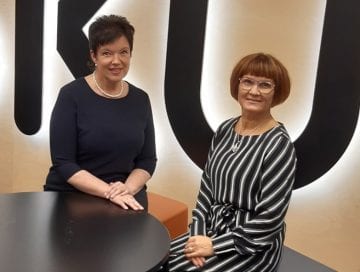Novel approaches to learning environment design

Elise Tarvainen,
COO,
Isku International,
Finland
Tiina Malste,
Manager,
Learning Design,
Finland
Designing learning environments requires balancing in the jungle of preferences; with the curriculum as a map, and the pedagogical know-how of teachers as a compass. Ideal learning environment arrangements are a source of inspiration for all operators in the school community.
Particularly within Early Childhood Education, the learning environment has been recognized as the third teacher, side by side with facilitating adults and peer learners. Why wouldn’t we take advantage of this perceptive finding at any level of education?
How can the learning spaces of today enhance the competences of tomorrow?
The competences that we believe are required in order to manage well in the future cannot be achieved in schools that were designed for our parents. A core task of today’s formal education is to prepare the learners for life, in environments that are integral parts of the life itself. Following the socio-constructivist conception of learning, we recognize the importance of knowledge and competences acquired in informal learning environments. All spaces are learning spaces!
Modern learning spaces encourage subject integration with active and participatory learning. The environment supports the learners from knowledge assimilators towards community-based knowledge and content creators. Improvements to the learning environment can be developed to classroom projects (e.g. health & safety, well-being, sustainable future), providing the students with most practical opportunities for competence building. Jointly, the school community can create an environment that takes its place in the frontline, shaping the future and showing the way towards social change.
The relationship between the learner and the learning environment can be seen as bi-directional: Student impacts the environment and in turn is impacted by the environment. Successful learning space solutions not only allow but rather attract and help teachers and students to use a variety of teaching and learning methods so as to better facilitate the achievement of future competences.
Can everyone be a learning environment designer?
In easily adjustable spaces, students can become active designers and developers of their own learning environment. The jointly selected solutions create an innovation platform reinforcing students’ own initiative and inspiring them to find, try and create novel solutions together. Involvement in the planning and constant re-shaping of their own learning spaces promotes students’ sense of agency and gives them the chance to show their strengths through their choices.
Tighter and looser members or the school community, as well as a wide variety of stakeholders should be considered as delightful sources of inspiration for learning design. Teachers, parents, designers, architects, and extra-curricular users are a natural consideration but also such as caterers, janitors, and cleaning staff become precious co-educators through engagement in the design and development process.
At best, the learning environment reflects the curriculum framework in use and is tailored for the respectively operating school community. Insights and ideas can be collected from existing examples through observation but the entity should not be copied.
The four pedagogical cornerstones for learning environment design
- In all decisions, focus on learning, instead of teaching. Provide the students with an opportunity to be active designers and developers of their own working environment.
- Create spaces that enhance the joy of learning and collaborative operational culture. Comfortable and functional spaces create peaceful working environments and contribute to the health and well-being of all members of the learning community.
- Check that the school facilities meet the objectives of the respective curriculum. Focus on objectives and the specific needs of different subjects and multi-disciplinary learning.
- Prioritize solutions that promote students’ own activity and accountability. Ideally, the learning environment allows for a variety of learning styles, enabling individualized learning paths and enhancing students’ self-directed learning.
Novel Finnish solution for quality learning
Finland has strong expertise in the design of learning and innovation environments. The school design sector in Finland is strong and advanced. The new flexible school environments support the learning process towards to objectives set in National Core Curriculum.
Finnish Isku Active Learning® solutions were developed to enhance the quality of learning – to improve both academic achievements and the quality of learning experiences. The complementary facility and furniture solutions – Focus, Share, Study & Join – are a source of inspiration, learning and creating something new. First and foremost, Isku Active Learning environments are safe, functional and enjoyable. They provide pedagogically versatile spaces where learning and teaching is a shared joy.
Expert article 2625
